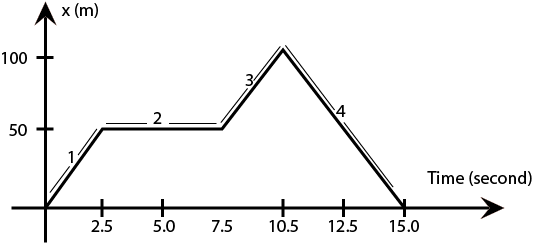
The figure shows the graph of the x-coordinate of a particle going along the x-axis as a function of time. Find (a) the average velocity during 0 to 10 seconds. (b) instantaneous velocity 2, 5, 8 and 12 sec.
(A) (a)1Mm/sec, (b) 20m/sec, zero, 20m/sec, -20m/sec.
(B) (a)20m/sec, (b) 15m/sec, zero, -10m/sec, 15m/sec.
(C) (a)15m/sec, (b) 15m/sec, 10m/sec, -15m/sec, 20m/sec.
(D) (a)25m/sec, (b) 10m/sec, -10m/sec, zero, 20m/sec.

Answer
218.4k+ views
Hint First, we will calculate displacement of an object from 0 to 10 seconds. Then we will calculate average velocity using the displacement value in formula $\bar \vee = \dfrac{{dx}}{{dt}}$ .
\[{V_{inst}} = \] slope of the graph is used to calculate instantaneous velocity.
Complete step by step solution:
Average velocity: It is defined as the rate of change of velocity of an object. It tells us how much displacement is done by an object in a specific time range.
Average velocity during 0 to 10 seconds = (total displacement) / (total time taken
\[ = \dfrac{{(100 - 0)}}{{10}}\]
=10m/sec
Instantaneous velocity = slope of graph
= change in y axis / change in x axis
Velocity at a particular instant is known as instantaneous velocity. Formula $\mathop {\lim }\limits_{t \to 0}^{} \dfrac{{\Delta x}}{{\Delta t}}$ is used in numerical calculations.
At 2 sec = slope of (1) $ = \dfrac{{50 - 0}}{{2.5 - 0}}$
=20m/sec
At 5 sec = slope of (2) $ = \dfrac{{50 - 50}}{{7.5 - 2.5}}$
= zero
At 8 sec = slope of (3) $ = \dfrac{{100 - 50}}{{10.5 - 7.5}}$
$ = \dfrac{{50}}{{2.5}}$
= 20m/sec
At 12 sec = slope of (4) $ = \dfrac{{0 - 100}}{{15 - 10}}$
$ = \dfrac{{ - 100}}{5}$
=-20m/sec
so, we are left with only one correct option I.e. (A) part.
Note:
Instantaneous velocity can be positive, zero, negative whereas average velocity should be positive always. We cannot use $\mathop {\lim }\limits_{t \to 0}^{} \dfrac{{\Delta x}}{{\Delta t}}$ to calculate instantaneous velocity. Since, we get average velocity as 10m/s
\[{V_{inst}} = \] slope of the graph is used to calculate instantaneous velocity.
Complete step by step solution:
Average velocity: It is defined as the rate of change of velocity of an object. It tells us how much displacement is done by an object in a specific time range.
Average velocity during 0 to 10 seconds = (total displacement) / (total time taken
\[ = \dfrac{{(100 - 0)}}{{10}}\]
=10m/sec
Instantaneous velocity = slope of graph
= change in y axis / change in x axis
Velocity at a particular instant is known as instantaneous velocity. Formula $\mathop {\lim }\limits_{t \to 0}^{} \dfrac{{\Delta x}}{{\Delta t}}$ is used in numerical calculations.
At 2 sec = slope of (1) $ = \dfrac{{50 - 0}}{{2.5 - 0}}$
=20m/sec
At 5 sec = slope of (2) $ = \dfrac{{50 - 50}}{{7.5 - 2.5}}$
= zero
At 8 sec = slope of (3) $ = \dfrac{{100 - 50}}{{10.5 - 7.5}}$
$ = \dfrac{{50}}{{2.5}}$
= 20m/sec
At 12 sec = slope of (4) $ = \dfrac{{0 - 100}}{{15 - 10}}$
$ = \dfrac{{ - 100}}{5}$
=-20m/sec
so, we are left with only one correct option I.e. (A) part.
Note:
Instantaneous velocity can be positive, zero, negative whereas average velocity should be positive always. We cannot use $\mathop {\lim }\limits_{t \to 0}^{} \dfrac{{\Delta x}}{{\Delta t}}$ to calculate instantaneous velocity. Since, we get average velocity as 10m/s
Recently Updated Pages
Arithmetic, Geometric & Harmonic Progressions Explained

Cartesian Form of Vector Explained: Formula, Examples & Uses

Apparent Frequency Explained: Formula, Uses & Examples

Calorimetry: Definition, Principles & Calculations

Centrifugal Force Explained: Definition, Formula & Examples

Charge in a Magnetic Field: Definition, Formula & Examples

Trending doubts
JEE Main 2026: Application Form Open, Exam Dates, Syllabus, Eligibility & Question Papers

Derivation of Equation of Trajectory Explained for Students

Hybridisation in Chemistry – Concept, Types & Applications

Understanding the Angle of Deviation in a Prism

Understanding Collisions: Types and Examples for Students

Understanding Atomic Structure for Beginners

Other Pages
JEE Advanced Marks vs Ranks 2025: Understanding Category-wise Qualifying Marks and Previous Year Cut-offs

Units And Measurements Class 11 Physics Chapter 1 CBSE Notes - 2025-26

NCERT Solutions For Class 11 Physics Chapter 8 Mechanical Properties Of Solids

Motion in a Straight Line Class 11 Physics Chapter 2 CBSE Notes - 2025-26

NCERT Solutions for Class 11 Physics Chapter 7 Gravitation 2025-26

How to Convert a Galvanometer into an Ammeter or Voltmeter




